PEUGEOT 2008 2015 Owners Manual
Manufacturer: PEUGEOT, Model Year: 2015, Model line: 2008, Model: PEUGEOT 2008 2015Pages: 340, PDF Size: 8.4 MB
Page 151 of 340
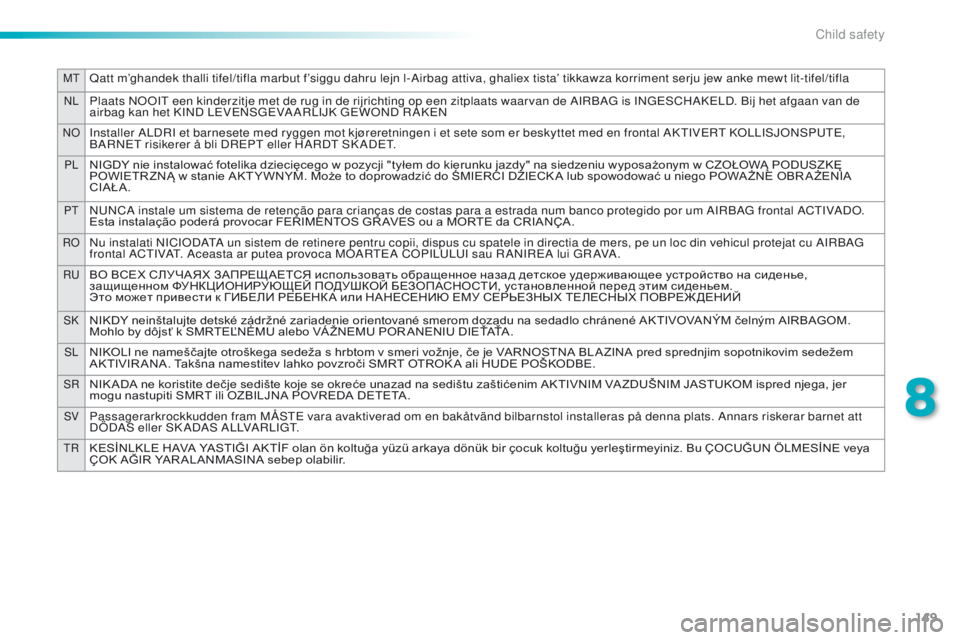
149
MTQatt m’ghandek thalli tifel/tifla marbut f’siggu dahru lejn l-Airbag attiva, ghaliex tista’ tikkawza korriment serju jew anke mewt lit-tifel/tifla
NLPlaats NOOIT een kinderzitje met de rug in de rijrichting op een zitplaats waar van de AIRBAG is INGESCHAKELD. Bij het afgaan van de
airbag kan het KIND LEVENSGEVA ARLIJK GEWOND R AKEN
NOInstaller ALDRI et barnesete med ryggen mot kjøreretningen i et sete som er beskyttet med en frontal AKTIVERT KOLLISJONSPUTE,
BARNET risikerer å bli DREPT eller HARDT SK ADET.
PLNIGDY nie instalować fotelika dziecięcego w pozycji "tyłem do kierunku jazdy" na siedzeniu wyposażonym w CZOŁOWĄ PODUSZKĘ
POWIETR ZNĄ w stanie AKT Y WNYM. Może to doprowadzić do ŚMIERCI DZIECK A lub spowodować u niego POWA ŻNE OBR A ŻENIA
CIAŁA.
PTNUNCA instale um sistema de retenção para crianças de costas para a estrada num banco protegido por um AIRBAG frontal ACTIVADO.
Esta instalação poderá provocar FERIMENTOS GR AVES ou a MORTE da CRIANÇA.
RONu instalati NICIODATA un sistem de retinere pentru copii, dispus cu spatele in directia de mers, pe un loc din vehicul protejat cu AIRBAG
frontal ACTIVAT. Aceasta ar putea provoca MOARTEA COPILULUI sau R ANIREA lui GR AVA.
RUВО ВСЕХ СЛУЧА ЯХ ЗАПРЕЩАЕТСЯ использовать обращенное назад детское удерживающее устройство на сиденье,
защищенном ФУНКЦИОНИРУЮЩЕЙ ПОДУШКОЙ БЕЗОПАСНОСТИ, установленной перед этим сиденьем.
Это может привести к ГИБЕЛИ РЕБЕНК А или НАНЕСЕНИЮ ЕМУ СЕРЬЕЗНЫХ ТЕЛЕСНЫХ ПОВРЕЖ ДЕНИЙ
SKNIKDY neinštalujte detské zádržné zariadenie orientované smerom dozadu na sedadlo chránené AKTIVOVANÝM čelným AIRBAGOM.
Mohlo by dôjsť k SMRTEĽNÉMU alebo VÁ ŽNEMU POR ANENIU DIEŤAŤA.
SLNIKOLI ne nameščajte otroškega sedeža s hrbtom v smeri vožnje, če je VARNOSTNA BLA ZINA pred sprednjim sopotnikovim sedežem
AKTIVIR ANA. Takšna namestitev lahko povzroči SMRT OTROK A ali HUDE POŠKODBE.
SRNIK ADA ne koristite dečje sedište koje se okreće unazad na sedištu zaštićenim AKTIVNIM VA ZDUŠNIM JASTUKOM ispred njega, jer
mogu nastupiti SMRT ili OZBILJNA POVREDA DETETA.
SVPassagerarkrockkudden fram MÅSTE vara avaktiverad om en bakåtvänd bilbarnstol installeras på denna plats. Annars riskerar barnet att
DÖDAS eller SK ADAS ALLVARLIGT.
TRKESİNLKLE HAVA YASTIĞI AKTİF olan ön koltuğa yüzü arkaya dönük bir çocuk koltuğu yerleştirmeyiniz. Bu ÇOCUĞUN ÖLMESİNE veya
ÇOK AĞIR YAR ALANMASINA sebep olabilir.
2008_en_Chap08_securite-enfants_ed01-2015
8
Child safety
Page 152 of 340
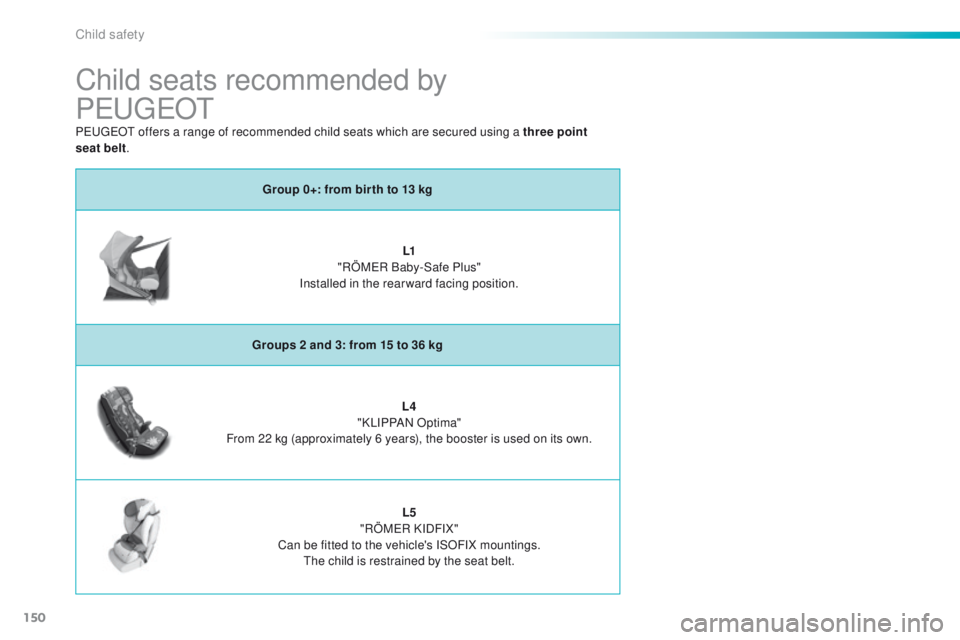
150
2008_en_Chap08_securite-enfants_ed01-2015
Child seats recommended by
PEUGEOT
Group 0+: from bir th to 13 kgL1
"RÖMER Baby-Safe Plus"
Installed in the rearward facing position.
Groups 2 and 3: from 15 to 36 kg L4
"KLIPPAN Optima"
From 22 kg (approximately 6 years), the booster is used on its own.
L5
"RÖMER KIDFIX"
Can be fitted to the vehicle's ISOFIX mountings. The child is restrained by the seat belt.
PEUGEOT offers a range of recommended child seats which are secured using a three point
seat
belt
.
Child safety
Page 153 of 340
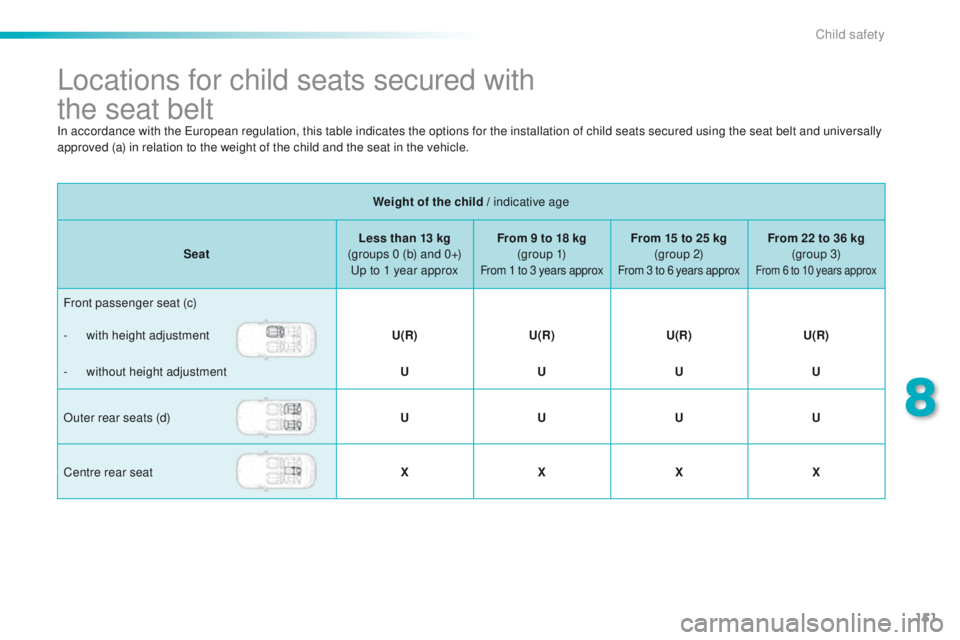
151
2008_en_Chap08_securite-enfants_ed01-2015
Locations for child seats secured with
the seat belt
Weight of the child / indicative age
Seat Less than 13 kg
(groups 0 (b) and 0+) Up to 1 year approx From 9 to 18 kg
(g r o u p 1)
From 1 to 3 years approx
From 15 to 25 kg (group 2)
From 3 to 6 years approx
From 22 to 36 kg (group 3)
From 6 to 10 years approx
Front passenger seat (c)
-
w
ith height adjustment U(R) U(R) U(R)U(R)
-
w
ithout height adjustment UUUU
Outer rear seats (d) UUUU
Centre rear seat XXXX
In accordance with the European regulation, this table indicates the options for the installation of child seats secured using the seat belt and universally
approved (a) in relation to the weight of the child and the seat in the vehicle.
8
Child safety
Page 154 of 340
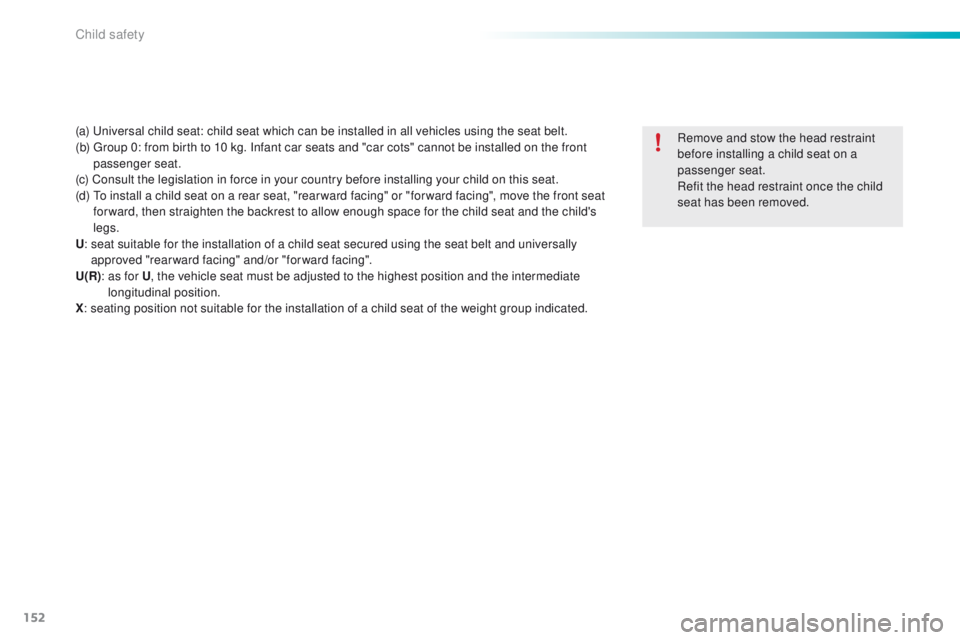
152
2008_en_Chap08_securite-enfants_ed01-2015
(a) Universal child seat: child seat which can be installed in all vehicles using the seat belt.
(b) G roup 0: from birth to 10 kg. Infant car seats and "car cots" cannot be installed on the front
passenger seat.
(c) Consult the legislation in force in your country before installing your child on this seat.
(d)
T
o install a child seat on a rear seat, "rear ward facing" or "for ward facing", move the front seat
for ward, then straighten the backrest to allow enough space for the child seat and the child's
legs.
U :
s
eat suitable for the installation of a child seat secured using the seat belt and universally
approved "rearward facing" and/or "forward facing".
U(R) :
a
s for U, the vehicle seat must be adjusted to the highest position and the intermediate
longitudinal position.
X : seating position not suitable for the installation of a child seat of the weight group indicated. Remove and stow the head restraint
before installing a child seat on a
passenger seat.
Refit the head restraint once the child
seat has been removed.
Child safety
Page 155 of 340
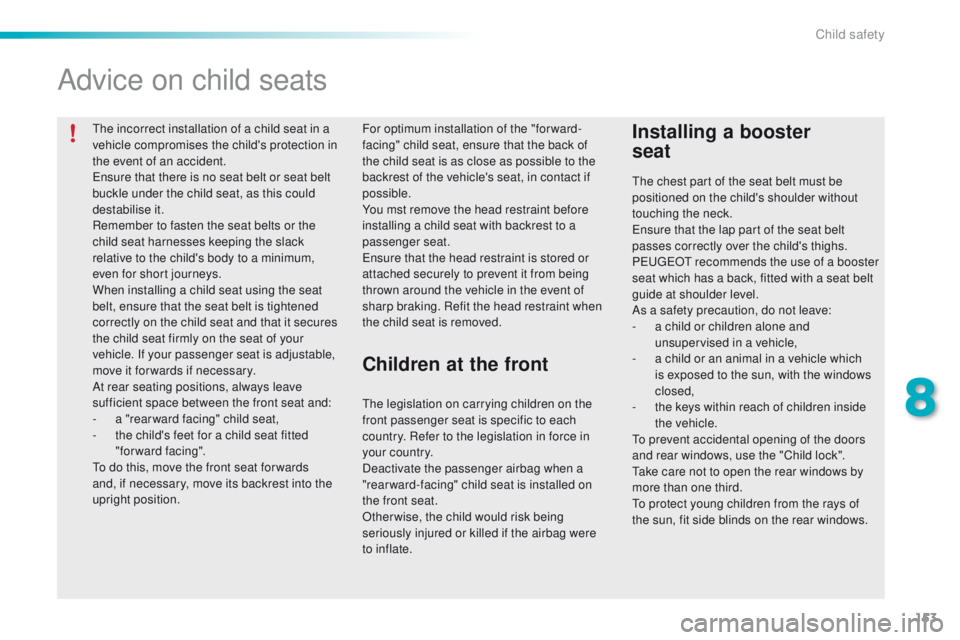
153
2008_en_Chap08_securite-enfants_ed01-2015
The incorrect installation of a child seat in a
vehicle compromises the child's protection in
the event of an accident.
Ensure that there is no seat belt or seat belt
buckle under the child seat, as this could
destabilise it.
Remember to fasten the seat belts or the
child seat harnesses keeping the slack
relative to the child's body to a minimum,
even for short journeys.
When installing a child seat using the seat
belt, ensure that the seat belt is tightened
correctly on the child seat and that it secures
the child seat firmly on the seat of your
vehicle. If your passenger seat is adjustable,
move it for wards if necessary.
At rear seating positions, always leave
sufficient space between the front seat and:
-
a "
rear ward facing" child seat,
-
t
he child's feet for a child seat fitted
"forward facing".
To do this, move the front seat for wards
and, if necessary, move its backrest into the
upright position.
Advice on child seats
Installing a booster
seatFor optimum installation of the "forward-
facing" child seat, ensure that the back of
the child seat is as close as possible to the
backrest of the vehicle's seat, in contact if
possible.
You mst remove the head restraint before
installing a child seat with backrest to a
passenger seat.
Ensure that the head restraint is stored or
attached securely to prevent it from being
thrown around the vehicle in the event of
sharp braking. Refit the head restraint when
the child seat is removed.
Children at the front
The legislation on carrying children on the
front passenger seat is specific to each
country. Refer to the legislation in force in
your country.
Deactivate the passenger airbag when a
"rear ward-facing" child seat is installed on
the front seat.
Otherwise, the child would risk being
seriously injured or killed if the airbag were
to inflate. The chest part of the seat belt must be
positioned on the child's shoulder without
touching the neck.
Ensure that the lap part of the seat belt
passes correctly over the child's thighs.
PEUGEOT recommends the use of a booster
seat which has a back, fitted with a seat belt
guide at shoulder level.
As a safety precaution, do not leave:
-
a c
hild or children alone and
unsupervised in a vehicle,
-
a c
hild or an animal in a vehicle which
is exposed to the sun, with the windows
closed,
- t he keys within reach of children inside
the vehicle.
To prevent accidental opening of the doors
and rear windows, use the "Child lock".
Take care not to open the rear windows by
more than one third.
To protect young children from the rays of
the sun, fit side blinds on the rear windows.
8
Child safety
Page 156 of 340
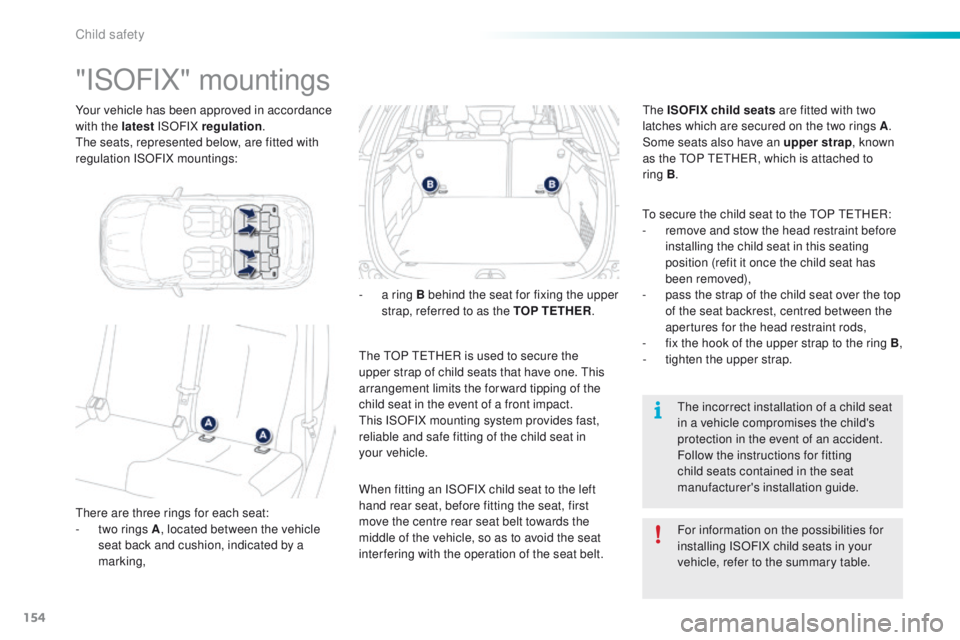
154
2008_en_Chap08_securite-enfants_ed01-2015
Your vehicle has been approved in accordance
with the latest ISOFIX regulation .
The seats, represented below, are fitted with
regulation ISOFIX mountings:
"ISOFIX" mountings
There are three rings for each seat:
- t wo rings A , located between the vehicle
seat back and cushion, indicated by a
marking, When fitting an ISOFIX child seat to the left
hand rear seat, before fitting the seat, first
move the centre rear seat belt towards the
middle of the vehicle, so as to avoid the seat
interfering with the operation of the seat belt.
For information on the possibilities for
installing ISOFIX child seats in your
vehicle, refer to the summary table.
-
a r
ing B behind the seat for fixing the upper
strap, referred to as the TOP TETHER .
The TOP TETHER is used to secure the
upper strap of child seats that have one. This
arrangement limits the forward tipping of the
child seat in the event of a front impact.
This ISOFIX mounting system provides fast,
reliable and safe fitting of the child seat in
your
vehicle.To secure the child seat to the TOP
TETHER
:
-
r
emove and stow the head restraint before
installing the child seat in this seating
position (refit it once the child seat has
been removed),
-
p
ass the strap of the child seat over the top
of the seat backrest, centred between the
apertures for the head restraint rods,
-
f
ix the hook of the upper strap to the ring B,
-
t
ighten the upper strap.
The incorrect installation of a child seat
in a vehicle compromises the child's
protection in the event of an accident.
Follow the instructions for fitting
child seats contained in the seat
manufacturer's installation guide.
The ISOFIX child seats are fitted with two
latches which are secured on the two rings A
.
Some seats also have an upper strap , known
as the TOP TETHER, which is attached to
ring B
.
Child safety
Page 157 of 340
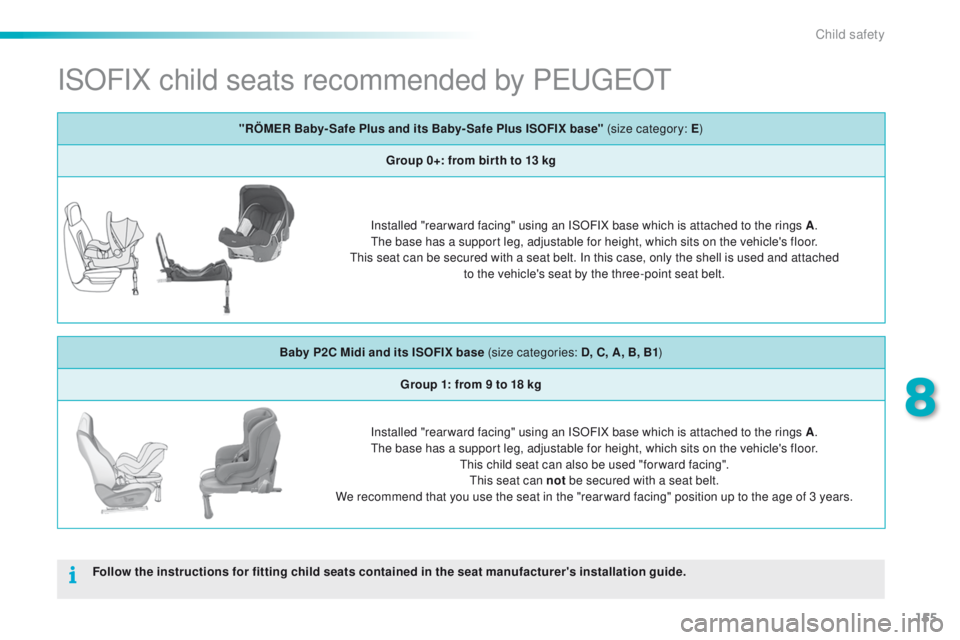
155
2008_en_Chap08_securite-enfants_ed01-2015
ISOFIX child seats recommended by PEUGEOT
Follow the instructions for fitting child seats contained in the seat manufacturer's installation guide."RÖMER Baby- Safe Plus and its Baby- Safe Plus ISOFIX base" (size category: E
)
Group 0+: from bir th to 13 kg
Installed "rear ward facing" using an ISOFIX base which is attached to the rings A .
The base has a support leg, adjustable for height, which sits on the vehicle's floor.
This seat can be secured with a seat belt. In this case, only the shell is used and attached to the vehicle's seat by the three-point seat belt.
Baby P2C Midi and its ISOFIX base (size categories: D, C, A, B, B1 )
Group 1: from 9 to 18 kg
Installed "rear ward facing" using an ISOFIX base which is attached to the rings A .
The base has a support leg, adjustable for height, which sits on the vehicle's floor. This child seat can also be used "for ward facing".This seat can not be secured with a seat belt.
We recommend that you use the seat in the "rear ward facing" position up to the age of 3 years.
8
Child safety
Page 158 of 340
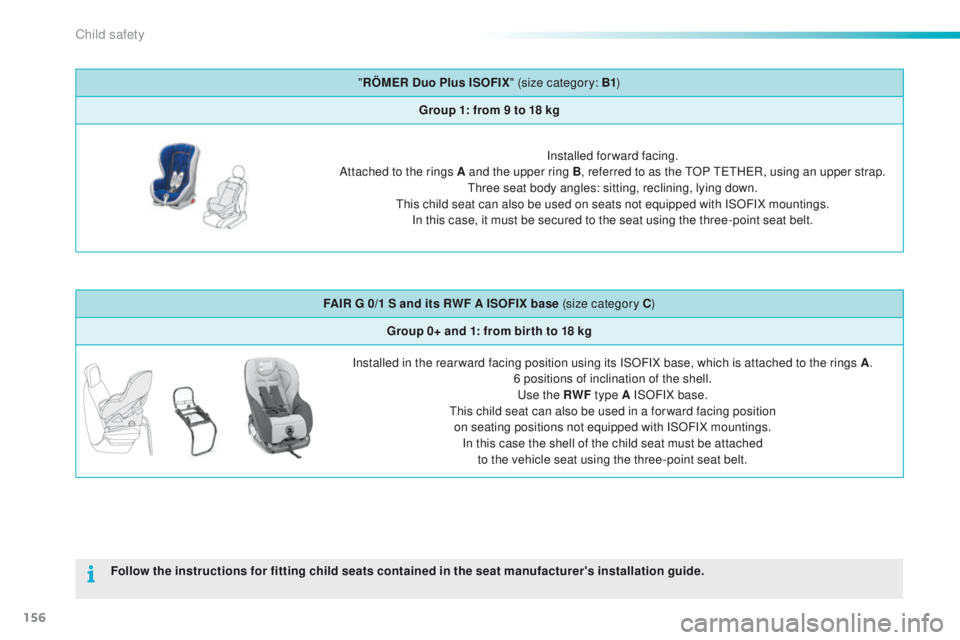
156
2008_en_Chap08_securite-enfants_ed01-2015
"RÖMER Duo Plus ISOFIX " (size category: B1)
Group 1: from 9 to 18 kg
Installed forward facing.
Attached to the rings A and the upper ring B, referred to as the TOP TETHER, using an upper strap. Three seat body angles: sitting, reclining, lying down.
This child seat can also be used on seats not equipped with ISOFIX mountings. In this case, it must be secured to the seat using the three-point seat belt.
FAIR G 0/1 S and its RWF A ISOFIX base (size category C)
Group 0+ and 1: from bir th to 18 kg
Installed in the rear ward facing position using its ISOFIX base, which is attached to the rings A .
6 positions of inclination of the shell. Use the RWF type A ISOFIX base.
This child seat can also be used in a for ward facing position on seating positions not equipped with ISOFIX mountings. In this case the shell of the child seat must be attached to the vehicle seat using the three-point seat belt.
Follow the instructions for fitting child seats contained in the seat manufacturer's installation guide.
Child safety
Page 159 of 340
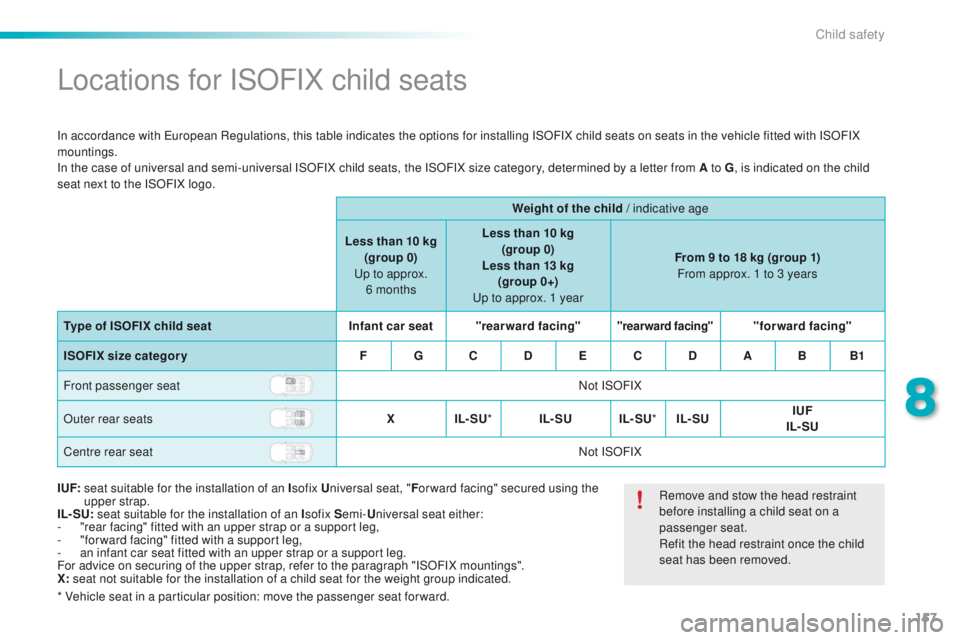
157
2008_en_Chap08_securite-enfants_ed01-2015
Locations for ISOFIX child seats
In accordance with European Regulations, this table indicates the options for installing ISOFIX child seats on seats in the vehicle fitted with ISOFIX
mountings.
In the case of universal and semi-universal ISOFIX child seats, the ISOFIX size category, determined by a letter from A to G, is indicated on the child
seat next to the ISOFIX logo.
Weight of the child / indicative age
Less than 10 kg (group 0)
Up to approx. 6 months Less than 10 kg
(group 0)
Less than 13 kg (group 0+)
Up to approx. 1 year From 9 to 18 kg (group 1)
From approx. 1 to 3 years
Type of ISOFIX child seat Infant car seat"rearward facing"
"rearward facing""forward facing"
ISOFIX size categor y F G C D E C D A B B1
Front passenger seat Not ISOFIX
Outer rear seats XIL- SU* IL- SU IL- SU *IL- SU IUF
IL- SU
Centre rear seat Not ISOFIX
I UF:
sea
t s uitable for the installation of an I sofix Universal seat, " For ward facing" secured using the
upper strap.
IL- SU: seat suitable for the installation of an I sofix Semi-Universal seat either:
-
"
rear facing" fitted with an upper strap or a support leg,
-
"
for ward facing" fitted with a support leg,
-
a
n infant car seat fitted with an upper strap or a support leg.
For advice on securing of the upper strap, refer to the paragraph "ISOFIX mountings".
X: seat not suitable for the installation of a child seat for the weight group indicated.
* Vehicle seat in a particular position: move the passenger seat for ward. Remove and stow the head restraint
before installing a child seat on a
passenger seat.
Refit the head restraint once the child
seat has been removed.
8
Child safety
Page 160 of 340
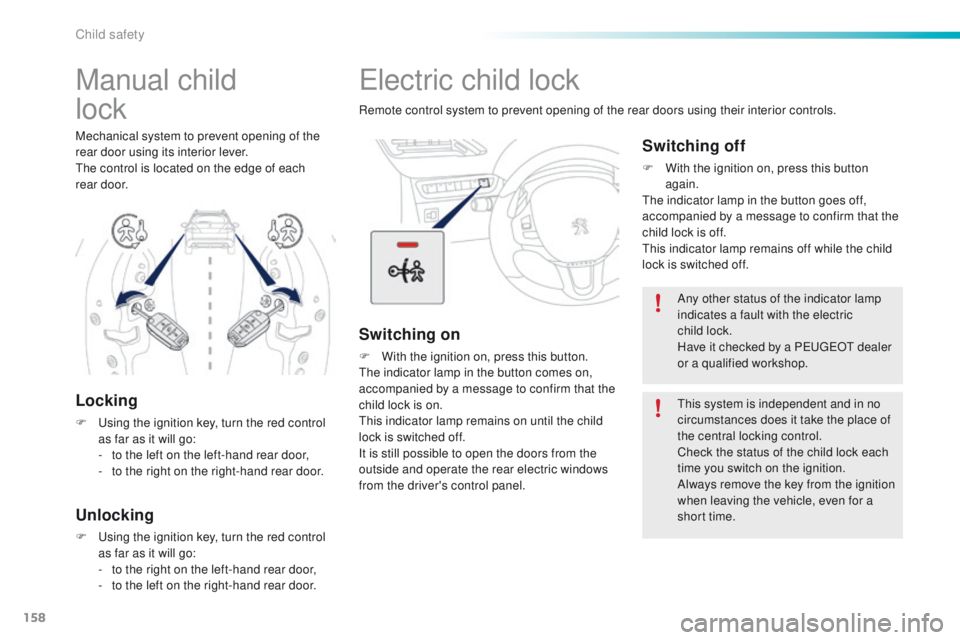
158
2008_en_Chap08_securite-enfants_ed01-2015
Electric child lock
Remote control system to prevent opening of the rear doors using their interior controls.
Switching on
F With the ignition on, press this button.
The indicator lamp in the button comes on,
accompanied by a message to confirm that the
child lock is on.
This indicator lamp remains on until the child
lock is switched off.
It is still possible to open the doors from the
outside and operate the rear electric windows
from the driver's control panel.
Switching off
F With the ignition on, press this button again.
The indicator lamp in the button goes off,
accompanied by a message to confirm that the
child lock is off.
This indicator lamp remains off while the child
lock is switched off.
Any other status of the indicator lamp
indicates a fault with the electric
child
lock.
Have it checked by a PEUGEOT dealer
or a qualified workshop.
This system is independent and in no
circumstances does it take the place of
the central locking control.
Check the status of the child lock each
time you switch on the ignition.
Always remove the key from the ignition
when leaving the vehicle, even for a
short time.
Manual child
lock
Locking
F Using the ignition key, turn the red control as far as it will go:
-
t
o the left on the left-hand rear door,
-
t
o the right on the right-hand rear door.
Unlocking
F Using the ignition key, turn the red control as far as it will go:
-
t
o the right on the left-hand rear door,
-
t
o the left on the right-hand rear door.
Mechanical system to prevent opening of the
rear door using its interior lever.
The control is located on the edge of each
rear
door.
Child safety